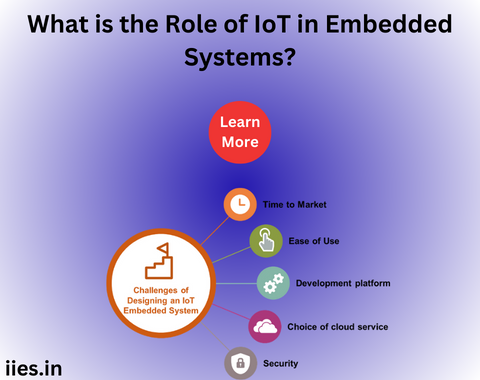
In the rapidly evolving landscape of technology, two key players have emerged as catalysts for transformative change: the Internet of Things (IoT) and Embedded Systems. Together, they form a dynamic synergy that is reshaping the way we interact with the world around us. This article explores the intricacies of IoT and Embedded Systems, their interdependence, and the revolutionary impact they have on various industries.
The Internet of Things, commonly referred to as IoT, is a network of interconnected devices that communicate and share data seamlessly over the internet. These devices can range from everyday household items like smart thermostats and refrigerators to industrial machinery and wearable devices. The essence of IoT lies in its ability to gather, process, and analyze data in real-time, providing valuable insights and enhancing efficiency in numerous applications.
1. Connectivity:
IoT devices are equipped with communication protocols such as Wi-Fi, Bluetooth, Zigbee, or cellular networks, enabling them to establish connections and share information.
2. Data Collection:
Sensors and actuators embedded in IoT devices collect data from the environment, user interactions, or other connected devices.
3. Cloud Integration:
IoT devices often leverage cloud computing for data storage, processing, and analysis, allowing for scalable and efficient operations.
4. Automation:
IoT facilitates automation by enabling devices to make informed decisions based on real-time data, reducing human intervention and enhancing overall efficiency.
Understanding Embedded Systems
Embedded Systems form the backbone of IoT, serving as the hardware foundation that enables devices to function seamlessly. These systems are embedded into everyday objects and machinery, providing intelligence and control.
1. Real-Time Operation: Embedded systems are designed to respond to inputs and generate outputs in real-time, making them crucial for time-sensitive applications.
2. Specialized Hardware: These systems often use specialized hardware tailored to the specific requirements of the application, optimizing performance and energy efficiency.
3. Low Power Consumption: Many embedded systems operate on minimal power to ensure longevity and reduce the need for frequent maintenance or battery replacements.
4. Reliability: Embedded systems are engineered for high reliability, as they are often deployed in critical applications where failure is not an option.
The Interplay of IoT and Embedded Systems
The synergy between IoT and Embedded Systems is evident in their interdependence. IoT relies on embedded systems to provide the hardware foundation and computational power needed to process and analyze data. Embedded systems, in turn, benefit from the connectivity and data-sharing capabilities of IoT to enhance their functionality.
1. Hardware Integration: Embedded systems serve as the hardware backbone for IoT devices, incorporating microcontrollers, sensors, and actuators to enable communication and data processing. This integration allows for the creation of smart, connected devices with enhanced capabilities.
2. Real-Time Processing: The real-time processing capabilities of embedded systems are crucial for IoT applications that require immediate responses. Whether it’s adjusting the temperature of a smart thermostat or controlling the speed of an autonomous vehicle, embedded systems ensure timely and accurate execution of tasks.
3. Edge Computing: Embedded systems play a pivotal role in the implementation of edge computing, a paradigm that involves processing data closer to the source rather than relying solely on cloud resources. This not only reduces latency but also alleviates the burden on network bandwidth.
Applications and Impact
The combined force of IoT and Embedded Systems has led to groundbreaking advancements across various industries, revolutionizing the way we live and work.
1. Smart Home Automation: IoT-enabled embedded systems power smart home devices, allowing users to control lighting, thermostats, security systems, and more from their smartphones.
2. Healthcare: In the healthcare sector, wearable devices equipped with embedded systems and IoT connectivity monitor vital signs, track physical activity, and enable remote patient monitoring. This real-time data facilitates proactive healthcare interventions and improves patient outcomes.
3. Industrial IoT (IIoT): Industrial sectors leverage IoT and embedded systems for predictive maintenance, asset tracking, and process optimization. IIoT enhances efficiency, reduces downtime, and enables data-driven decision-making in manufacturing, logistics, and energy sectors.
4. Smart Cities: The integration of IoT and embedded systems in urban infrastructure contributes to the development of smart cities. Intelligent transportation systems, waste management, and environmental monitoring enhance the quality of life for urban dwellers while promoting sustainability.
Despite the immense potential of IoT and Embedded Systems, their widespread adoption is not without challenges.
1. Security Concerns: The interconnected nature of IoT devices raises concerns about data security and privacy. Ensuring robust security measures in both embedded systems and IoT networks is crucial to safeguard sensitive information.
2. Standardization: The lack of standardized protocols and communication standards hinders seamless interoperability among different IoT devices. Establishing common standards is essential to promote a cohesive and interconnected IoT ecosystem.
3. Power Consumption: Many IoT devices, especially those in remote or inaccessible locations, face challenges related to power consumption. Developing energy-efficient embedded systems and exploring alternative power sources are essential for sustainable IoT deployments.
4. Scalability: As the number of connected devices continues to grow, scalability becomes a critical consideration. Designing IoT systems and embedded solutions that can scale effectively to accommodate increasing demands is imperative.
The convergence of IoT and Embedded Systems represents a paradigm shift in the way we perceive and interact with technology. From smart homes to industrial applications, the symbiotic relationship between these two technologies is reshaping industries and influencing the way we live and work. As we navigate the challenges and capitalize on the opportunities presented by IoT and Embedded Systems, the future promises a more connected, intelligent, and efficient world.
Indian Institute of Embedded Systems – IIES